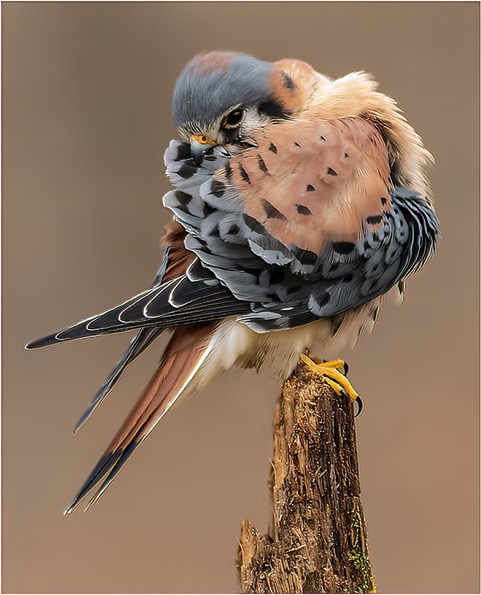Natural History Miscellany: “Grooming Time Predicts Survival: American Kestrels, Falco sparverius, on a Subtropical Island”
Posted on
by
.jpeg)
Photo credit: Andy Byerly
Grooming is a behavior observed in animals to care for their body surfaces. In birds, grooming consists of cleaning and arranging feathers, distributing preen oil that waterproofs the feathers and helps in odor-based communication, and clawing to get rid of any parasites among the feathers. All these behaviors may affect a bird’s health, although we lack concrete evidence of these potential links.
Many birds invest around 5-15% of their time in grooming on average, which may lead to tradeoffs if birds are grooming at the expense of activities like foraging and reproduction. This led Dr. Sarah Bush and Dr. Dale Clayton from the University of Utah to wonder: is there a relation between bird grooming and survival? To address this question, they conducted a field observation study of kestrels. They selected kestrels for this question due to their abundance and ability to be tamed, which makes them suitable for ‘capture, mark, and observe’ studies. Over the course of two years, they monitored a population of non-migratory American kestrels on the island of San Salvador in the Bahamas. Kestrels were selected for this study due to their abundance and ability to be tamed, which makes them suitable for ‘capture, mark, and observe’ studies. They banded seventy-two birds, collected data on their grooming behavior and parasite abundance, and measured their survival.
The authors found that kestrels who groomed an intermediate amount had the highest survival. This could be explained by the fact that low grooming rates may result in poor plumage (feather) quality which could impact mating success and increase parasite infection rates, while high rates may indicate that the bird is experiencing stress. Surprisingly, birds that groomed more did not have lower parasite loads, and a bird’s parasite load did not affect their survival. This may imply that the dynamics of parasite load and grooming are not tightly linked, or that the parasites found on the birds of this island may not be highly detrimental to the health of the birds. Bush and Clayton’s work is the first study to demonstrate a relationship between grooming behavior and survival. However, we do not currently know whether grooming behavior is a cause or a consequence of changes in survival probability, and it would be interesting to identify the mechanism through which grooming impacts survival.
Abstract
Animals have evolved a variety of adaptations to care for their body surfaces, such as grooming behavior, which keeps the integument clean, parasite-free, and properly arranged. Despite extensive research on the grooming of mammals, birds, and arthropods, the survival value of grooming has never been directly measured in natural populations. We monitored grooming and survival in a population of marked American kestrels (Falco sparverius) on San Salvador Island, Bahamas. We found a strong association between time spent grooming and survival over a 2-year period. The quadratic relationship we show is consistent with stabilizing natural selection on grooming time. To our knowledge, this is the first evidence for a correlation between grooming time and survival in a natural population. Grooming time may predict the survival of many animal taxa, but additional studies are needed to determine the shape and strength of the relationship among birds, mammals, and arthropods.

Photo credit: Shubha Govindarajan
Author Bio:
Shubha Govindarajan is a PhD student with Deepa Agashe at the National Centre for Biological Sciences, Bengaluru, Karnataka, India. She is working on questions related to adaptation and niche expansion using flour beetles. Her additional interests include classical dance, music and literature.